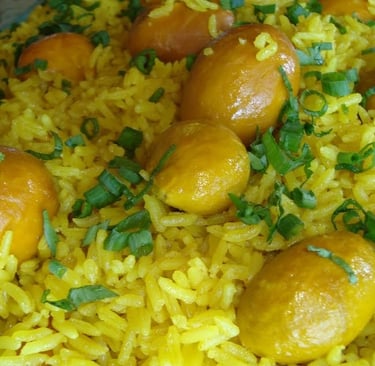Pequi Rice (Arroz com Pequi)
Pequi Rice (Arroz com Pequi). Pequi is a fruit native to Brazil, specifically to the ecosystems of the Cerrado, one of the largest tropical savannas in the world. It does not naturally grow in the Amazon or the Atlantic Forest; its true home is the dry, vast, biodiverse heartland of Brazil.
RECIPE
Unveiled Brazil
11/17/20255 min read


🍚 Pequi Rice (Arroz com Pequi) – English Recipe
Ingredients
2 cups of white rice (frutopedia.com.br)
4 to 8 pequi fruits (fresh or canned) (Monólogos do Arroz)
1 medium onion, diced (amp.tudogostoso.com.br)
2 garlic cloves, minced (amp.tudogostoso.com.br)
¼ cup of vegetable oil (or other neutral oil) (amp.tudogostoso.com.br)
4 cups of hot water (amp.tudogostoso.com.br)
Salt to taste (amp.tudogostoso.com.br)
(Optional) Brazilian chili pepper (“pimenta-de-cheiro” or malagueta) (CyberCook)
(Optional) Fresh parsley and green onion (parsley & scallion) for garnish (amp.tudogostoso.com.br)
Instructions
Prepare the Pequi
If using fresh pequi, wash them well. (frutopedia.com.br)
Be careful with the seeds (“caroço”) — pequi has tiny spines under the pulp, so don’t bite directly into the seed. (CyberCook)
If using canned pequi, drain the liquid and use the pequi slices. (Sabores Ajinomoto)
Sauté Aromatics
In a medium saucepan, heat the oil over medium heat. (Sabores Ajinomoto)
Add the diced onion and garlic, and sauté until the onion softens and becomes slightly golden. (nacozinhadahelo.com.br)
Add the pequi and sauté for a few more minutes, allowing its fragrance to infuse the oil. (frutopedia.com.br)
Add Rice
Stir in the rice, mixing well so that each grain is coated with the aromatic oil and pequi. (nacozinhadahelo.com.br)
Cook with Water
Pour in the hot water and season with salt to taste. (frutopedia.com.br)
You may also add chili pepper at this stage, if you like a spicy kick. (receitas.band.com.br)
Cover the pan partially and cook on low heat until the rice absorbs the water and the grains are tender but not mushy. (nacozinhadahelo.com.br)
Rest and Finish
Remove the pan from heat, cover it fully, and let the rice rest for about 5 minutes. This helps the grains to settle and become more separate. (nacozinhadahelo.com.br)
Fluff the rice gently with a fork. (nacozinhadahelo.com.br)
Garnish with chopped parsley and scallion, if using. (amp.tudogostoso.com.br)
Serve
Serve hot, as a side dish or as a main, depending on preference. The pequi’s rich, buttery, slightly wild flavor makes this rice both aromatic and distinctive.
Tips & Safety Notes
Be careful with pequi seeds: The fruit has tiny spines under the pulp which can hurt if chewed directly. (jbb.ibict.br)
Oil matters: Using a neutral oil is fine, but if you have pequi oil, it elevates the flavor and makes the dish more authentic.
Water temperature: Use boiling or very hot water to help the rice cook evenly.
Adjust seasoning: The pequi flavor is strong. Start with less chili or salt, taste midway, and adjust as needed.
🎥 Two Popular YouTube Videos for Pequi Rice
Here are two highly viewed or well-known YouTube videos that show how to make “Arroz com Pequi / Pequi Rice”:
Ótima ideia — aqui está um texto em inglês para incluir na sua receita, com recomendações de onde comprar pequi nos EUA e na Europa, além de links úteis:
Where to Buy Pequi (in the U.S. and Europe)
If you're outside Brazil and want to make arroz com pequi or experiment with other pequi recipes, you might wonder: where can I buy pequi? Here are some reliable sources in the United States and Europe, plus tips to find different pequi products.
🇺🇸 Buying Pequi in the United States
Everyday Brazil (Online Brazilian Grocery)
Pequi Sliced 300 g (“Sabor Mineiro”) — sold at Everyday Brazil, a U.S.-based Brazilian supermarket online. (Todo Brasil)
Pequi Sauce (“Molho de Pequi”) — also available in their sauce section. (Todo Brasil)
Shipping: They ship around the U.S., and for orders over a certain amount there may be free shipping, depending on your location. (Todo Brasil)
RememBR Store
Pequi Sliced (“Pequi Fatiado Aroma de Minas”), 140 g. (RememBR)
This is a more niche Brazilian-foods import shop, good for finding regional ingredients like pequi.
🇪🇺 Buying Pequi in Europe
If you're in Europe, here are some online stores and European Brazilian-food retailers that offer pequi products:
Made in Market (EU)
Preserved Pequi Pulp, 260 g — Great for cooking; comes in brine. (Made in Market)
Sliced Pequi, 130 g (Aroma D’Minas) — Ready to use in rice, stews, etc. (Made in Market)
Mon Petit Brésil / D’Horta
Whole Pequi Fruit with Seed (D’Horta) – 590 g jar. (Made in Market)
Pequi Cream (Creme de Pequi) – 200 g. This is more of a spreadable pequi pulp, great for sauces. (Mon Petit Brésil)
Pequi Pieces (D’Horta) – 310 g jar. (Brasil-Latino)
Pequi Oil (“Óleo de Pequi”) 150 ml. Cold-pressed oil from the fruit, with a distinct aroma; ideal for flavoring rice or salad. (Brasil-Latino)
Brasil-Latino (German / European Latino Food Store)
D’Horta Pequi-Creme 200 g. € 6.60, 1–3 days delivery within EU. (Brasil-Latino)
D’Horta Pequi-Oil 150 ml. € 7.71, good option for gourmet or cooking use. (Brasil-Latino)
Delícias UK (UK Brazilian Food Shop)
Aroma D’Minas Sliced Pequi 300 g. £6.65. (delicias-uk.com)
💡 Tips for Buying Pequi Abroad
Choose the right format: Pequi comes in many forms — sliced, whole with seed, pulp, cream, or even oil. For arroz com pequi, the sliced pequi or preserved pulp are the most convenient.
Check shelf life: Canned or preserved pequi has a much longer shelf life than fresh fruit, which is hard to ship internationally.
Shipping costs: Brazilian specialty stores in the U.S. may charge for shipping depending on your ZIP code. In Europe, costs and import duties vary a lot between countries.
Storage: Once opened, store pequi pulp or slices in the fridge and use them within a few days (or follow the instructions of the seller).
Experiment first: Pequi has a very strong, unique flavor. If you're buying it for the first time, consider ordering a small jar so you can test it before using a large amount in recipes.
Pequi is a fruit native to Brazil, specifically to the ecosystems of the Cerrado, one of the largest tropical savannas in the world. It does not naturally grow in the Amazon or the Atlantic Forest; its true home is the dry, vast, biodiverse heartland of Brazil.
Here is a clear breakdown:
Where Pequi Comes From
🇧🇷 Native Region: The Brazilian Cerrado
Pequi (scientific name Caryocar brasiliense) grows naturally in the Cerrado biome, a huge savanna covering central Brazil. Major states where pequi is traditionally found and consumed:
Goiás
Minas Gerais
Tocantins
Mato Grosso
Mato Grosso do Sul
Bahia (western region)
Distrito Federal (Brasília)
The Cerrado is known for:
Dry winters
Rainy summers
Acidic soil
Fire-adapted vegetation
High biodiversity (second only to the Amazon in Brazil)
Pequi trees are extremely resistant and can survive drought, heat, and yearly natural fires.
🌱 Cultural and Historical Background
Pequi has been eaten for centuries by:
Indigenous peoples (Xavante, Karajá, Krahô, Kalunga communities)
Afro-Brazilian quilombola communities
Rural populations of the Cerrado
It became a staple ingredient in the regional cuisine long before colonization.
Today, pequi is a symbol of Cerrado culture, especially in cities like:
Goiânia
Belo Horizonte / Minas Gerais interior
Cuiabá
Palmas
Montes Claros
Many families still have “pequizeiros” (pequi trees) on their properties.
🥘 What Makes Pequi Special?
Strong, unmistakable aroma
Rich, buttery pulp
High in healthy fats
Used in traditional dishes such as Arroz com Pequi, Galinhada com Pequi, and even liqueurs and oils
It is so culturally important that in Goiás, the pequi harvest marks the beginning of summer festivals, and some towns celebrate the Festa do Pequi every year.
🌍 Does Pequi Grow Outside Brazil?
Rarely.
It can be found in very small quantities in:
Bolivia
Paraguay
But the best, most aromatic pequi is Brazilian Cerrado pequi.
Commercial farming outside South America is extremely limited because the tree requires:
Cerrado-type soil
Long dry seasons
High heat
Specific ecological conditions
So nearly all exported pequi sold in the U.S. and Europe comes from central Brazil.
If you want, I can add this section to your SEO article or turn it into a standalone optimized page (“Where Pequi Comes From – Complete Guide”).
